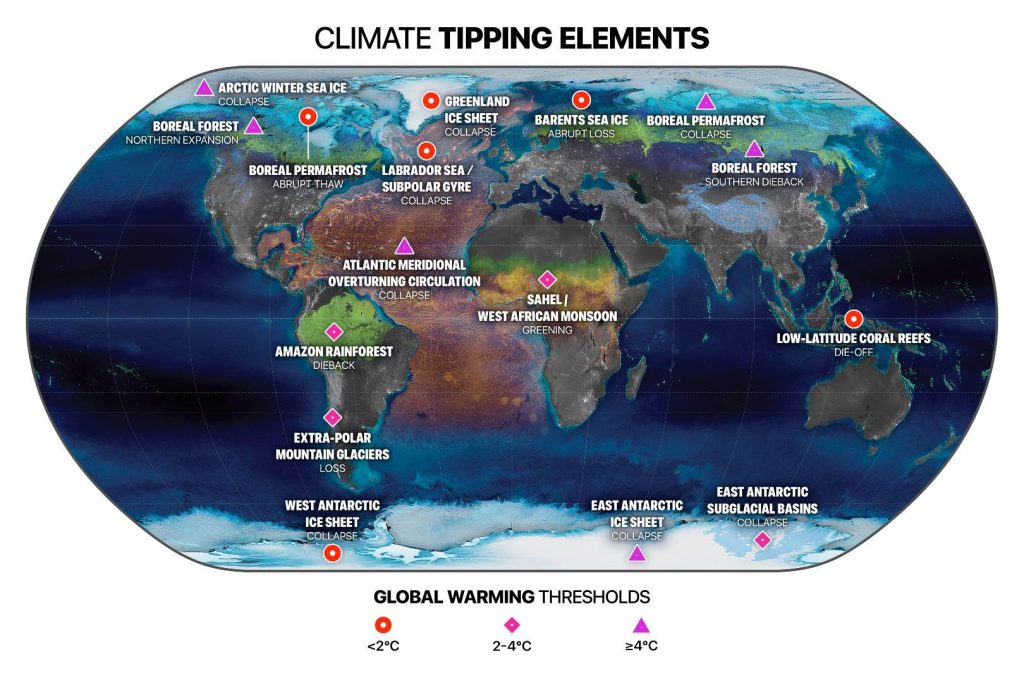
Click to enlarge: The location of climate tipping elements in the cryosphere (blue), biosphere (green) and ocean/atmosphere (orange), and global warming levels their tipping points will likely be triggered at. Summary Map by Earth Commission/Globaïa.
Multiple climate tipping points could be triggered if global temperature rises beyond 1.5°C above pre-industrial levels, according to a major new analysis published in the journal Science. Even at current levels of global heating the world is already at risk of passing five dangerous climate tipping points, and risks increase with each tenth of a degree of further warming.
An international research team synthesized evidence for tipping points, their temperature thresholds, timescales, and impacts from a comprehensive review of over 200 papers published since 2008, when climate tipping points were first rigorously defined. They have increased the list of potential tipping points from nine to sixteen.
The research concludes human emissions have already pushed Earth into the tipping points danger zone. Five of the sixteen may be triggered at today’s temperatures:
- The Greenland ice sheets
- West Antarctic ice sheets
- Widespread abrupt permafrost thaw
- Collapse of convection in the Labrador Sea
- Massive die-off of tropical coral reefs
Four of these move from possible events to likely at 1.5°C global warming, with five more becoming possible around this level of heating.
Already left safe climate
The Sixth Assessment Report of the Intergovernmental Panel on Climate Change (IPCC), stated that risks of triggering climate tipping points become high by around 2°C above preindustrial temperatures and very high by 2.5-4°C. This new analysis indicates that Earth may have already left a ‘safe’ climate state when temperatures exceeded approximately 1°C warming. A conclusion of the research is therefore that even the United Nations’ Paris Agreement goal to limit warming to well-below 2°C and preferably 1.5°C is not enough to fully avoid dangerous climate change.
According to the assessment, tipping point likelihood increases markedly in the ‘Paris range’ of 1.5-2°C warming, with even higher risks beyond 2°C.
The study provides strong scientific support for the Paris Agreement and associated efforts to limit global warming to 1.5°C, because it shows that the risk of tipping points escalates beyond this level. To have a 50% chance of achieving 1.5°C and thus limiting tipping point risks, global greenhouse gas emissions must be cut by half by 2030, reaching net-zero by 2050.
New tipping elements
The researchers categorized the tipping elements into nine systems that affect the entire Earth system, such as Antarctica and the Amazon rainforest, and a further seven systems that if tipped would have profound regional consequences. The latter include the West African monsoon and the death of most coral reefs around the equator.
Several new tipping elements such as Labrador Sea convection and East Antarctic subglacial basins have been added compared to the 2008 assessment, while Arctic summer sea ice and the El Niño Southern Oscillation (ENSO) have been removed for lack of evidence of tipping dynamics.
Co-author Ricarda Winkelmann, a researcher at the Potsdam Institute for Climate Impact Research and a member of the Earth Commission says, “Importantly, many tipping elements in the Earth system are interlinked, making cascading tipping points a serious additional concern. In fact, interactions can lower the critical temperature thresholds beyond which individual tipping elements begin destabilizing in the long-run.”
(Based on materials provided by the University of Stockholm.)


